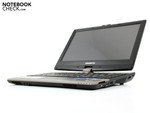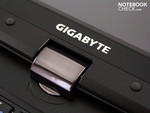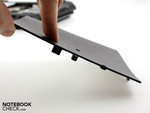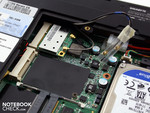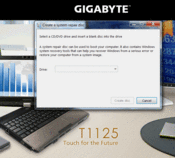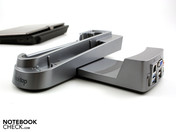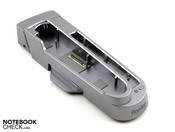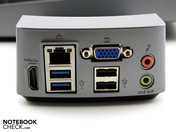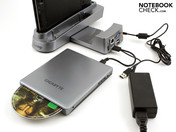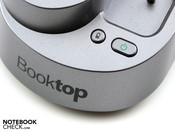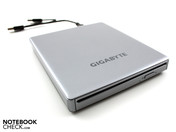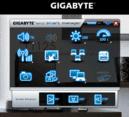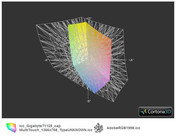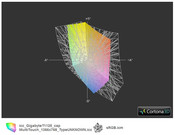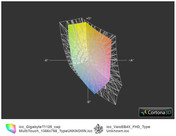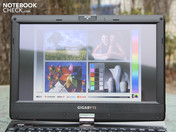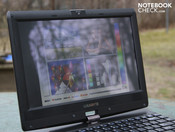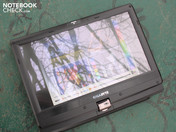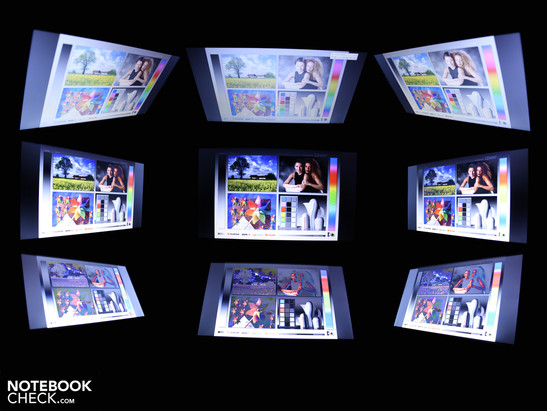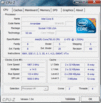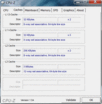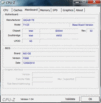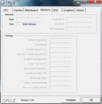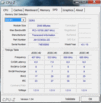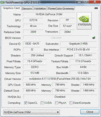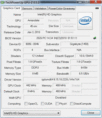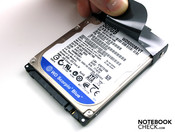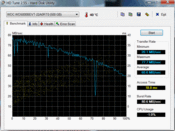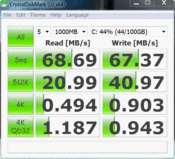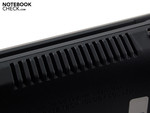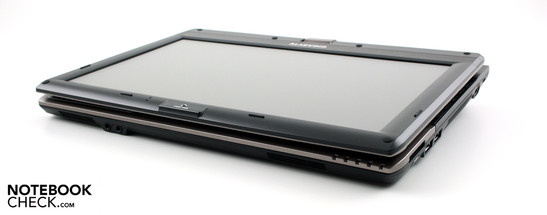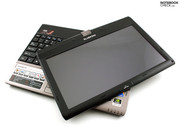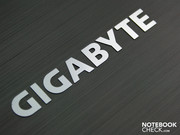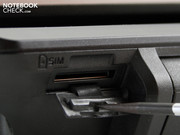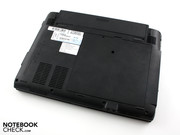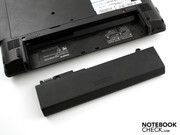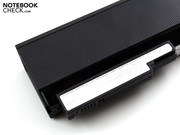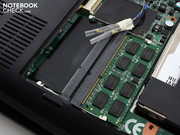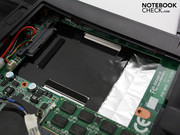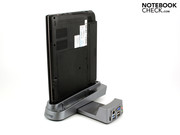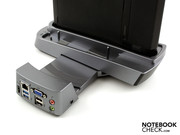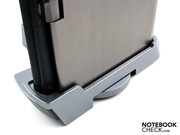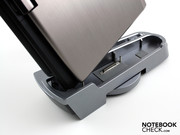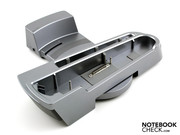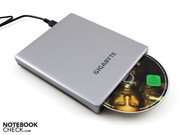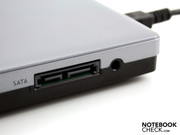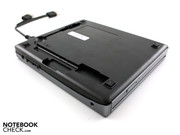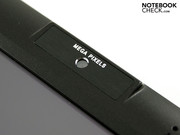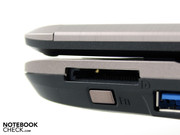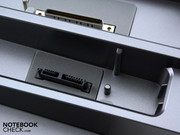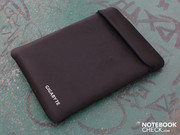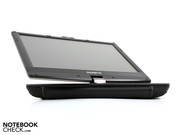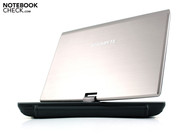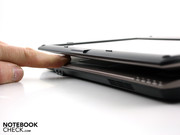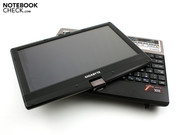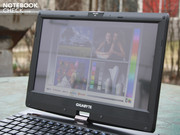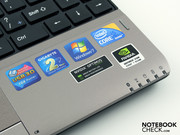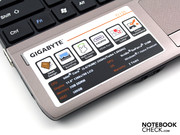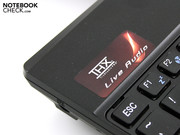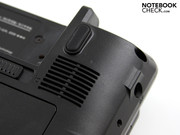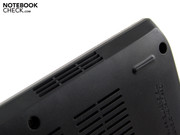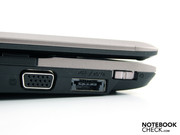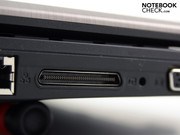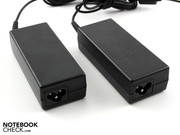Review Gigabyte Booktop T1125N & Docking Convertible

Gigabyte Technologies hasn't belonged to those notebook manufacturers who have engaged themselves massively in Germany until now. The manufacturer's motherboards and graphic cards are more famous. However, alike Asus originating from the same country, the Taiwanese from Gigabyte have started producing notebooks years ago. They have mainly been sold in Asia.
Merely a small number is retailed in Germany's stores, for example the 9 inch Convertible M912V or the UMPC U60 in 2008. Currently, we only find the odd Gigabyte Touch Note T1005M & T1000P with Intel's Atom N550, respectively N470, in stores. These 10.1 inchers are also convertible tablets, but they are not compatible with the presented Booktop docking station of our test device.
The Taiwanese ring in a new strategy with the Booktop T1125N. Instead of a solitary single tablet or subnotebook, a comprehensive desktop replacement solution with docking station and optical drive is offered for almost 1000 euros. The term "desktop replacement" may certainly give a few users an uneasy feeling since neither games nor hardware devouring workstation applications can be managed with the "power" of a Core i5-470UM and an NVIDIA GeForce 310M. Nevertheless, fact is that this performance can likely cover 80% of the home or occupational scenarios.
In this review, we'll check if the seldom seen guest from Taiwan bids a well-built, mobile convertible tablet and a well-conceived docking solution.
Case
The convertible's 11.6 inch case presents itself in a solidly built base unit and a stiff lid made of brushed aluminum. Base unit, wrist-rest (plastic in aluminum looks) and base plate have a praiseworthy torsional stiffness. The same applies to the lid with a rotatable multi-touch display.
The hinge, a challenge in the T1125N in terms of construction, isn't massive. The silver surface is a plastic cover. The hinge keeps the lid firmly in position and even rotating and stop indicate longevity. However the hinges mount on the base unit isn't completely stiff. The latter bends noticeably when we pull on the half turned lid with force. The battery positioned underneath the hinge has prevented a stronger, so better reinforced sub-construction.
The bottom can be opened via the maintenance cover. The 2.5 inch drive, two RAM slots (one empty), the WLAN module and an unoccupied mini PCIe slot is found underneath it. The latter could point at a 3G version since two antennas, a SIM slot and 3G modem software are prepared. The manufacturer's website speaks of a mobile broadband option (3.5G support).
Connectivity
A highlight of our test device is the configuration with connections via the docking solution. But the subnotebook itself bids a profound offer of ports with HDMI, 1 USB 3.0 and eSATA. The bottom and front accommodate a total of four speakers, but more on that in "Emissions". The port for the docking solution, GA-T1125, is on the left. Two feed holes on the port's left and right ensure an accurate assembly with the station.
Communication
The communication modules are contemporary. A GBE Family Controller (Realtek), a draft n WLAN (Atheros AR9285) and a Bluetooth module are installed. The latter works with the old 2.1+EDR standard.
Supplies
Besides the docking solution, GA-T1125 Dock, with its separate optical drive, no supplies other than a warranty card, driver & utility DVD and manual are found in the box. The system isn't overloaded with software. If you'd prefer to stick to the familiar Windows desktop, you'll not even notice Gigabyte's AppPark, or even need it. This small interface bids a central access point to frequently used programs. Not something that can't also be managed with a few desktop links.
The installed 3G modem tool indicates the 3G option (can be optionally bought: 3.5G UMTS/HSPA module from Gigabyte). Both Backup & Restore, as well as Create System Disc, serve data securing, respectively creating recovery data carriers.
Warranty
The manufacturer grants a 24 month warranty on the subnotebook and 12 months on both the battery and docking station. It's recommendable to register online for a smooth claim transaction (warranty S/N on base plate).
Booktop
The Gigabyte T1125N is currently only sold in the Booktop version, so including the docking station GA-T1125 Dock with a slot-in DVD. The optical drive is plugged (eSATA connection) and sold as a bundle with the Dock (199 euros). On the go, the DVD drive turns into a USB drive that doesn't need its own power source.
The T1125N can be inserted on the Dock as a tablet or as a closed subnotebook. The second, smaller bay is for the DVD drive. The variable 90 degree alignment allows cables to be moved out of sight, in case looking at the touchpad should be necessary during desktop utilization. This even makes home theater utilization imaginable.
HDMI and VGA are also looped through the Dock, just like Ethernet, USB 3.0 and audio. Only users of external eSATA hard disks will be unhappy because this port is covered by the dock and it isn't available on the station.
There is an alternative power on button on the Dock since the notebook's power slider is also covered. The subnotebook's battery status can be displayed via status LEDs by pressing the battery symbol immediately beside the power button (5 level indicator). A practical idea. A second, identical adapter is included so that the power cable doesn't have to be removed from the Dock when going in vacation. One of our adapters emitted an annoying whining noise, which is NOT a defect in the series. The customer should be entitled to a replacement in this case.
Input Devices
Keyboard
The keys in isolation look have a clear gap between them and exploit the entire case breadth. The arrow keys have pleasantly not been minimized, but the return and right shift key have in return. Nevertheless, typos are rare with a bit of practice.
The keyboard's weak point is the unclear pressure point and the soft stroke. It coils in the center key field area during typing. The key bed doesn't fit tight here. Consequently, the typing feel is spongy and doesn't support writing motivation and accuracy very much. When the chassis is bent extremely via its hinge, the inserted keyboard loosens itself at a point from the upper mount. This can be remedied by pressing it down with a finger, but reinforces the clattery impression.
Touchpad
The cursor moves accurately and with clear friction over the desktop (minute knobs). The pad is pleasant to use, when the loud but at least flexible keys (medium stroke length, clear pressure point) are avoided. It is a multi-touch pad (Elan Smart Pad), which detects two finger gestures, e.g. zoom, scroll. Fixed vertical and horizontal scroll fields have been omitted. They cannot be enabled in the Smart Pad software.
Multi-Touch
The capacitive multi-touch pad complies with the latest finger technology, used in all higher quality tablets and smartphones. Our conductive skin is crucial for this. Inputs via a pen (stylus pen), fingernails or other objects don't work (no gloves). Operating is fast and without any start problems. The surface detects when the palm of a hand is laid on it, but doesn't accept any inputs made on other positions.
When the finger is pressed heavily onto the LED screen, pressure marks turn up at the edges and partly under the finger. A fairly careful finger use might be necessary for a long duration of the multi-touch screen. You shouldn't entrust the T1125N in the inept hands of children already in view of the hinges flexibility. The lid, folded over to a tablet, has no mechanical catch apart from the hinge clearly locking.
Many Windows based tablet PCs have a switch for rotating the picture direction, respectively they automatically change the view depending on how it's held. The T1125N isn't capable of this. The Smart Manager Control Center comes into play so that you don't have to click your way through Windows' options. The tool is opened by a silver button on the right and bundles all important energy and application settings. Brightness, energy mode, volume, webcam, external monitors or USB Smart Charge (e.g. charge the iPod) can be set here with a finger. It can even disable multi-touch. However, it doesn't result in a longer battery life.
Display
With exception of the multi-touch quality, there is a simple HD consumer screen in the T1125N. It can only be read out as HF9D2_N116B6 without reference to the manufacturer. The 16:9 HD ready display has a resolution of 1366x768 pixels. A slight anti-reflective treatment is presented. The subtly recognizable coat is for capacitive inputs and not for deterring reflections.
The weak contrast of 183:1 isn't surprising since it's standard for office devices as well as many tablet PCs. The colors lack brilliancy. They look beached. The narrow color spectrum complies with the low contrasts. None of the three comparison color spectrums can be displayed. The T1125N is the colored, interior area in each graph.
| |||||||||||||||||||||||||
Brightness Distribution: 92 %
Center on Battery: 189 cd/m²
Contrast: 183:1 (Black: 1.13 cd/m²)
41.58% AdobeRGB 1998 (Argyll 3D)
59.4% sRGB (Argyll 3D)
40.29% Display P3 (Argyll 3D)
The 11.6 inch display's LED backlight lights the panel up to 211 cd/m2 at most. That is very sufficient for indoors. The average rate is 203 cd/m2. The illumination of 92% is very even.
A satisfying outdoor use is almost impossible with the reflective display. Reflections are already clearly disturbing in heavily overcast conditions (see pictures). In addition, the display automatically dims to 189 cd/m2 in battery mode (center). Thus, the T1125N isn't suitable for its big appearance in the summer outdoor restaurant.
The tight viewing angle stability speaks the language of a simple consumer TFT. Colors already falsify at narrow angles of about 45 degrees horizontally. However, writing remains well legible up to about 80 degrees. Image deviations, seen as dimming (bottom) or bleaching (top), turn up at only 15 degrees vertically. This is aggravating during tablet PC use because you often look upon the screen in a 45 degree angle.
Performance
Gigabyte uses a Core i5-470UM (32 nm, Arrandale). It is a typical low voltage CPU with a basic clock rate of 2x1.33 GHz and a TDP of 18 watts (UM models). The turbo function can boost the single core rate up to 1.86 GHz. Hyper Threading is more significant for multi core applications in practical use (four computing threads). If you'd like to save 100 euros, you can get the T1125N with a Core i3-380UM, as well.
Alike all i5 cores, the 470UM has a memory controller for a DDR3 main memory and an Intel HD graphics card installed. The 2GB RAM is located on one of two slots. Serial devices are however equipped with 4GB. Upgrading is easy via the base plate. There is room for a 2.5 inch notebook HDD in the case. In our case, it comes from Western Digital (WD5000BEVT-22A0RT0, 500 GB, 5400 rpm).
The Intel GMA is complemented by a dedicated NVIDIA GeForce 310M with a 512 MB video memory. Nvidia's Optimus technology allows the 310M to be disabled automatically, when its computing power isn't needed. The Intel HD always remains enabled because its frame buffer is used for video output. As a result, there aren't any annoying waiting times or black screens during switching.
We've checked the Core i5-470UM's performance with Cinebench R10 Single 64 bit, among others. The synthetic processor benchmark rewards the 470UM (2x1.33 GHz, 2436 points) with a performance on par with a Core i5-520UM (2x1.06 GHz, 2435 points). The 470UM and 520UM have an identical turbo rate of 1.86 GHz.
The Core i5 shows its strength in calculations with all available cores (Hyper Threading: 2 cores + 2 virtual cores). Cinebench R10 Multi (64 bit) finishes with strong 5036 points (520UM = 4179; i3-330M = 6600; i5-430M = 7800). The higher base rate supplies a small advantage in comparison to the 520UM. Strong notebook CPUs, such as an i5-480M (~8550 points) calculate a lot faster, but they also emit more waste heat (under load).
| PCMark Vantage Result | 3883 points | |
Help | ||
We experience the overall performance as smooth. Several simultaneously running programs don't put the T1125N under pressure. PCMark Vantage checks the interplay of CPU, graphics, RAM and hard disk. The result is 3883 points. Thus, the convertible is below that of an Acer Aspire 1830T (520UM), but above that of an Acer Travelmate 8172T (330UM). Nevertheless, the 470UM system is remote from standard processors as found in Sony's Vaio VPC-S13X9E (i3-370M, 13.3 inch, 5088 points).
The GeForce 310M's (512 MB DDR3) main task is to support the processor in HD decoding (H.264, MPEG-2, MPEG-4 etc.) and video coding (CUDA, OpenCL). It's doubtful if users really need the latter in an 11.6 incher. However, such a GPU makes sense for rendering Full HD movies. The 310M's CUDA support can be exploited in programs like Badaboom. But OpenCL programmers will definitely not buy a T1125M.
Any hope of gaming performance has to be stifled with 3622 3DMarks 2006 (1755 CPU score). At least this score is better than the Intel HD would achieve (about 1100 points). Nevertheless, the outdated 310M is remote from the performance of the latest midrange Radeon HD 6550 (depending on CPU, about 6800 to 7400 points).
| 3DMark 06 Standard Score | 3622 points | |
Help | ||
PCMark Vantage's subtotal only adds up to 2690 points. A good average for a 5400 rpm hard disk would be around 3500. The HDTune scores turn out accordingly low. The throughput in sequential read is 61 MB/s.
Crystal Disk Mark uses a different routine and gives a more detailed report about the read/write throughputs of small and large data packages. The small figures during reading and writing of random 4K packages are striking (0.5 / 0.9 MB/s). A faster 7200 rpm HDD accomplishes 0.8 / 1.7 MB/s in this exercise (ST9500420AS in the HP 4720s).
Emissions
System Noise
Such a subnotebook, convertible and tablet PC should stay pleasantly quiet in the ideal case. This can only be said about the T1125 in idle or low load. The fan rotates with a noise level of 31.2 dB(A) during surfing, emailing, or typing. It occasionally turns itself off completely (long idle periods), whereas the HDD's quiet noise remains audible as a subtle whirring with 31.7 dB(A).
The level increases to a noisy 44.4 dB(A) when the i5-470UM and the GeForce 310M is put under permanent load with Prime95 or Furmark. This maximum level stays consistent, but it sounds like a rocket engine. When only 3DMark06 loads the graphics, the level falls to 40.8 dB(A). This audible, but still endurable level can be mainly expected when a game is played on the T1125N. The fan management is overall refined and considered when the speeds are changed.
Noise level
| Idle |
| 31.2 / 31.2 / 31.2 dB(A) |
| HDD |
| 31.7 dB(A) |
| Load |
| 40.8 / 44.4 dB(A) |
 | ||
30 dB silent 40 dB(A) audible 50 dB(A) loud |
||
min: | ||
Temperature
The T1125N gets at most lukewarm during a scenario of short load and long idle states. The number pad increases to a maximum of 32 degrees. The warmest spot on the bottom is 40 degrees in the CPU area. The other areas stay considerably cooler.
We measure 33 degrees Celsius on the wrist-rest after a stress test. The maximum on the work surface is 37 degrees. The bottom heats up selectively to 47 degrees in this case. However, the average is only 32 degrees due to the otherwise cooler areas.
(+) The maximum temperature on the upper side is 37 °C / 99 F, compared to the average of 35.4 °C / 96 F, ranging from 19.6 to 60 °C for the class Convertible.
(-) The bottom heats up to a maximum of 47.6 °C / 118 F, compared to the average of 36.8 °C / 98 F
(+) In idle usage, the average temperature for the upper side is 29.9 °C / 86 F, compared to the device average of 30.3 °C / 87 F.
(+) The palmrests and touchpad are reaching skin temperature as a maximum (32.9 °C / 91.2 F) and are therefore not hot.
(-) The average temperature of the palmrest area of similar devices was 27.9 °C / 82.2 F (-5 °C / -9 F).
Speakers
The 11.6 incher comes with a total of four small speakers in sound issues. Two speakers, marked as tweeters, are located on the narrow front. The two woofers have been placed beside the rear feet. The latter develop their potential the best when the T1125N rests on the Docking. They would otherwise emit their sound toward the table.
The praised THX sound enhancements (Surround, Crystalizer, Speaker, Dialog Plus) can actually produce a balanced sound in the midranges and trebles. However, they can't provide basses or low pitches. If it is connected to the TV, its speakers, respectively an external system should be used for the sound output. The volume always remains undistorted, even in the maximum level.
Battery Life
The T1125N's battery life is 3:11 hours in WLAN surfing and a brightness of 100 cd/m2 (191 minutes). We loaded only a few YouTube clips and visited news sites in this time. Our test determined 156 minutes in the DVD test. However, we didn't use the external DVD drive, but played an Avi movie from the hard disk.
If you are very frugal and work without WLAN in the lowest brightness setting, you can draw well four hours with maximum energy savings. The maximum – but unrealistic – runtime (BatteryEater Reader's Test) is 256 minutes. The 7800 mAh battery is ready for the next session after 3:25 hours. This is how long the battery needs for recharging after a complete discharge.
The battery life could possibly be increased with a few settings in the bios. The following functions or devices can definitely be disabled: WLAN, Bluetooth, 3G, webcam, USB 3.0, Turbo Boost, Nvidia Optimus 310M, Intel VGA performance.
The tight battery life, for subnotebook conditions, is due to a slightly increased power consumption. The measurements at the power socket (battery capacity at 100%) show 11.8 to 17.7 watts in idle. In comparison, a Lenovo IdeaPad U260 needs 6.8 up to 12.2 watts, a Dell Vostro V130 consumes 10 to 14 watts. Both comparison systems have the same i5-470UM processor.
The power consumption alters considerably under load. When the i5-470UM is solely loaded by the processor stress test, the multimeter indicates 41.6 watts. When Furmark is added, the power consumption increases to 61.5 watts. 3DMark06 alone consumes 48.1 watts. The Geforce 310M is definitely the cause for this in the T1125N. Similar systems with only an Intel HD consume about 30 watts (stress test): Acer Aspire 1830T (520UM) needs 30.3 watts; Vostro V130 needs 29 watts.
| Off / Standby | |
| Idle | |
| Load |
|
Key:
min: | |
Verdict
The concept is successful. A PC-complete package runs into the German harbors for a bit less than 1000 euros with the Booktop T1125N. It still is a unique solution for avoiding secondary or tertiary PC in this price range. Users have a flexible device for all purposes at hand with the T1125N.
The T1125N is a high resolution tablet PC, even if weight and bulkiness make it a bit unhandy in its use. It is a handy subnotebook, although with a limited battery life of well three hours. It is a small sized desktop replacement with many interfaces and optical drive, when it's placed on its Docking. And finally, in the docking position, the T1125N is also an entertainer aka Home Theater PC (HTPC) with four speakers, THX sound effects and touchscreen.
The T1125N will be first choice for some users since data synchronization and switching among three device categories isn't necessary. The Booktop's potential buyer shouldn't be a fan of high performance CPUs and gaming. The Optimus graphics, Geforce 310M, and the Core i5-470UM (low voltage) just does not have enough computing power for this purpose. But if you don't render videos, play the latest games or edit enormous Gimp files, you'll find the work speed pleasantly smooth.
The downsides are found in the spongy keyboard, the fairly short battery life and the weak contrasts as well as the narrow viewing angles of the screen. The (still) omitted 3G module appears to be in preparation since the full size mini PCIe, two antennas, a SIMCard slot and 3G modem software are all set. An upgrade option may become possible.




